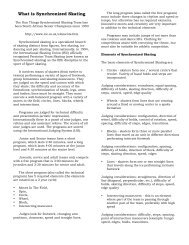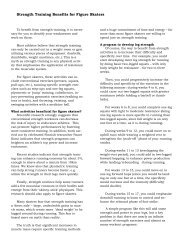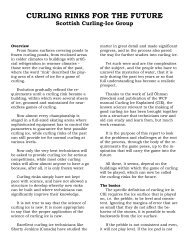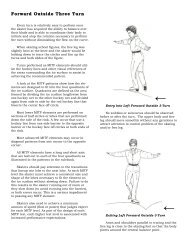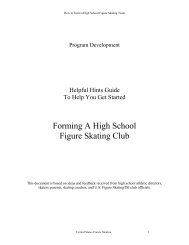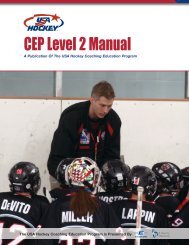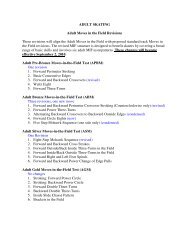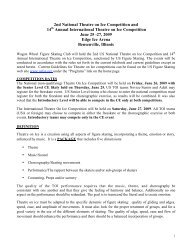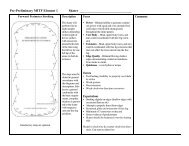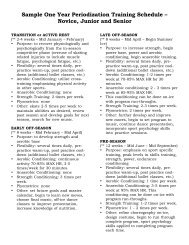CEP Level 3 Manual - Rushmore Hockey Association
CEP Level 3 Manual - Rushmore Hockey Association
CEP Level 3 Manual - Rushmore Hockey Association
You also want an ePaper? Increase the reach of your titles
YUMPU automatically turns print PDFs into web optimized ePapers that Google loves.
T A B L E O F C O N T E N T SDepending on their age level, players might say:• skating to avoid other players• avoiding goal posts while driving tothe net• keeping your stick down• not losing control on the ice• controlling your temper• knowing when you’re about to get hit or bechecked• preparing for impact along the boardsNow it’s time to tell them Rule One of “HeadsUp <strong>Hockey</strong>”: in hockey, “Heads Up” literally meansexactly what it says: “Keep your head up on the ice,especially when it looks like you’re going to take ahit.”Tell players that this is the single most importantthing to know and to do to prevent head injuries andtell them that you’re going to be looking for it fromnow on. Explain that most people duck when theysee a hit coming, but doing so puts them in danger.DRILL #1Heads Up — Say it LoudDuring your first on-ice “Heads Up <strong>Hockey</strong>”session, you don’t need any specific drills or plays toreinforce what you’ve told you team. Just watchtheir play, and shout “Heads Up” from time to timethroughout the session. Use it to remind players tokeep alert, to point out unsafe situations and toencourage skaters to keep their heads up, whetherthey’re skating or sliding after a fall.ANGLING INSkating into the boards at an angle means better puckcontrol and less risk of injury.When the puck goes into a corner, everybodywants to dig it out and dig it out fast. But what’s thebest way to get it out? And what’s the safest way?Skating in on an angle is the best and the safest way.• Skating in on an angle affords players a betterapproach angle to the puck, and by giving thebody a safe position to accept an impact withthe boards, it allows players to keep skatingand gain control of the puck.• When players skate into the corners at anangle, the risk of hitting the boards with theirhelmets first is greatly reduced. A leg, side orarm will absorb most of the impact.Start this “Heads Up <strong>Hockey</strong>” discussion byinviting players to imagine a puck moving through acorner when they’re close to the nearest end zoneface-off dot. How should they go after the puck andwhy?Now ask players to imagine the same puckmoving the same way, but with an opponent behindthem. Should there be any difference in theapproach? Why?After getting answers from several players,explain the advantages of skating to the puck on anangle, rather than head-on into the boards.When demonstrating “angling in” be sure tocover these points:• Go in on an angle.• Keep a low center of gravity.• Knees bent, back straight and head up.• Absorb the shock over the widest. possiblepart of your body.• Keep your feet parallel to the boards.• Forearms – hands – legs ready.• Lean into the impact.• Never hit the boards or glass with the tip ofyour shoulder – it can cause an injury.• Check over your shoulder to see where youropponent is.Drill #21. Set up two lines of four players (A and B)behind the face-off dots and a pile of pucks(P) in the left corner.2. On the whistle, the first player on the leftface-off spot (A) angles into the corner, picksup a puck, skates behind the net and makes apass to (B), who has moved from the face-offspot to the slot area.3. Player (B) takes a shot on goal and joins the(A) line. Player (A) goes to the (B) line.VariationsB B BBA• Halfway through the drill, move the pucks tothe right corner so that players learn to pickup a puck and pass off both the forehandand backhand.• A coach can stand to the side of the (A) lineand slide a puck into the corner one at atime.• For age levels with body checking, add a lineof chasers who try to catch the puck carrierand angle him or her into the boards.HITTING THE BOARDSBGood ways and bad ways to have a closeencounter with a goal post, the boards or anotherplayer.It’s going to happen: you play hockey, you’regoing to skate into things. But how players skateinto the boards, the goal post or another player isimportant for their safety as well as their ability tostay in the play.Here are two simple rules:A A AA• Don’t duck• Hit the boards with anything but your headfirstIn section 1, you told players why they shouldn’tduck their head on impact - here’s an opportunity toreinforce it.Start discussion by asking players what theyshould hit the boards with first when they know animpact is coming.They might answer:• an arm• their back• a skate• a leg• their side• their stickAll of these, of course, are right answers. Playersprobably won’t say “your head” as a possibleanswer, and you should congratulate the players forthat.Conclude your discussion by demonstrating thebest way to cushion an impact with the boards:with both hands on the stick if possible, and withtheir arms out creating a three-part “shockabsorber”. Players should try to absorb the impactover as much of their body as possible.Drill #31. Set up two lines of players (A and B) at theface-off dots.2. On the whistle, a player from each line skatesat an angle toward the corner boards. Theplayers should make contact with the boardsand glass with their extended arms, forearms,side of body and legs but with no headcontact at all.3. Players should alternate between lines (A)and (B). The speed at which the players hitthe boards must be managed, depending onthe skill level of the players. Proper head,arms and body position must be stressed.B B BBA A AA60 | USA <strong>Hockey</strong> Coaching Education Program <strong>Level</strong> 3 <strong>Manual</strong>Risk Management | 61



